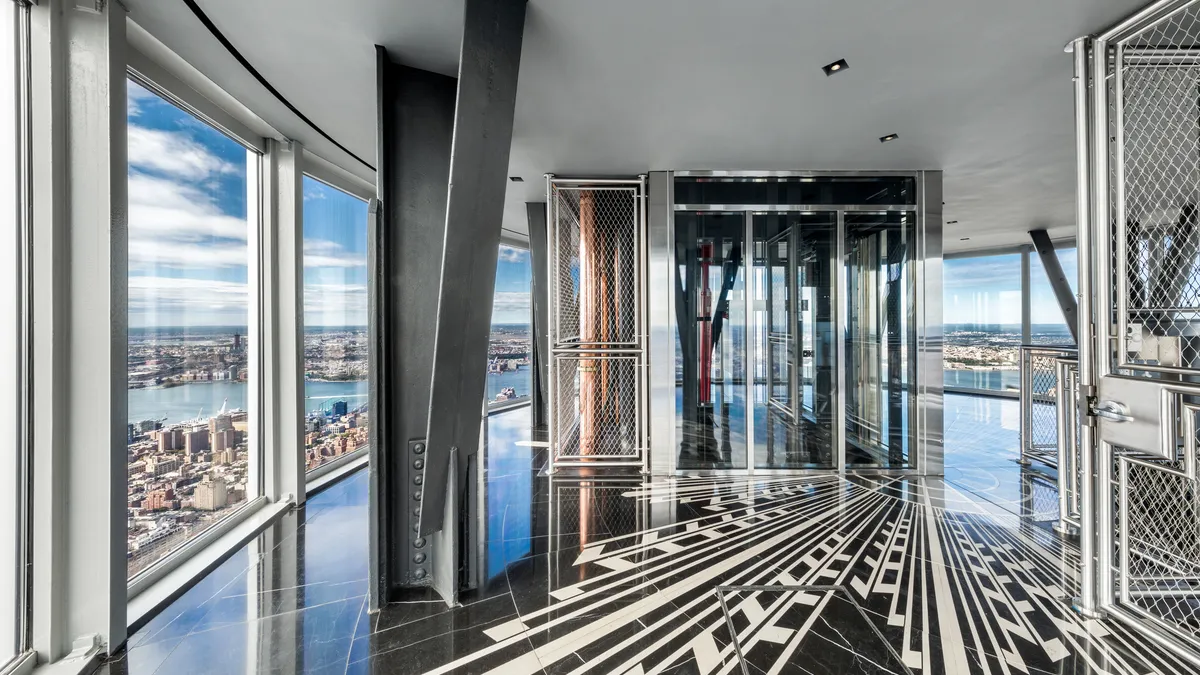Extreme heights, exacting materials and harsh winter weather were just a few of the challenges facing Skanska USA's recent renovation of the observation deck on one of the world's most iconic buildings.
Adding to the constraints, the renovation of the 102nd floor of the Empire State Building in New York City had to be completed while a visitor terrace below was open to the public.
The culmination of a four-year reimagining of the building’s visitor experience, the $165 million observation deck project involved replacing the old windows — which only reached waist height — with 360-degree floor-to-ceiling glazing offering unobstructed, panoramic views of the city. In addition, developer Empire State Realty Trust required that an 86th floor visitor terrace remained open to the public throughout the construction.
“It was paramount to the client that their guest experience not be interrupted and that our work remained as 'invisible' as possible to those visiting the observatory,” said Kevin Brightly, project manager, Skanska USA Building.
Working at such great heights — at times more than 1,250 feet off the ground — presented unique challenges that required unique engineering solutions, Brightly told Construction Dive. An exterior crane or material hoist was out of the question given the need to keep the terraces open to the public from 8 a.m. to 2 a.m. every day and minimize the need for extensive overhead protection, he said.
To complete this complex renovation without disrupting normal building operations, Skanska and partners Plan B Engineering and Greg Beeche Logistics employed an innovative “cocoon” enclosure system to facilitate construction while protecting workers from the elements and visitors below.
This approach required extensive engineering and plan review before construction began, according to Brightly, and included analysis of the cocoon not only in its final configuration but also in partially constructed and dismantled scenarios.
The team relied on a variety of construction technology systems to design and implement the cocoon, including RISA-3D, Revit, Inventor and extensive laser scanning and BIM modeling.
Before it could be constructed, a structural “halo” with a hoisting carriage was first built around the 103rd Floor; this system was then used to assemble and hoist 16 trapezoidal modules from Level 90 to 102 where they were docked and connected to one another in succession. The exterior work was performed nightly between the hours of 2 a.m. to 7 a.m., Brightly said.
Upon completion, the 26-foot-tall, 30-ton cocoon provided 600 square feet of exterior work space across two deck levels. Its bottom deck was rated for 300 pounds per square foot and its sidewalls of Haki sheeting were designed to withstand 98-mph wind gusts. The walls were lined with wire mesh screens and debris netting so that no material could escape during demolition or construction, Brightly said.
Protective enclosure
With the protective cocoon in place, the Skanska team was able to demolish the existing façade and replace it with the new glass exterior, which is comprised of two dozen 450-pound glass units measuring eight feet wide. The veneer curtain wall system was mounted to original building steel and incorporates custom exterior trim pieces that were designed to match the historic aesthetic of the iconic façade.
The team also removed several mechanical shafts and replaced them with transparent mesh enclosures to improve sightlines for guests. The renovation also included miniature LED floodlights that are programed to adjust color based on time of day.
The cocoon allowed for quick, safe work, Brightly said.
“In just over two months we performed demolition of original windows and cladding; installation of new slab edge steel and concrete; new veneer curtain wall system and support steel; and new waterproofing membrane from floors 101 to 103 … all within the cocoon, out of the public eye," he said.
A focus on safety
In addition to the cocoon, other safety measures on site included a 100% tie-off policy for exterior work; mandated full body harnesses for workers and tethering for all tools, materials and equipment; and rock-climbing style hard hats with chin straps. Exterior scaffolding work and deliveries were only performed between 2 a.m. and 7 a.m., when the observation deck was closed to the public.
The weather at such extreme heights was often unpredictable, Brightly said, and snow, ice and high winds pelted the site for much of the winter. “Many nights crews would come in based on forecast and weather conditions at street level, but by 2 a.m. conditions would change and we could not perform exterior hoisting,” he said.
Logistics at 100 stories up required extensive advance planning. All materials had to pass through four different elevators to get from the loading dock to the 102nd floor and the glass for exterior windows was too large for one of these elevators, so crews used the empty hoistway to rig glass from floors 80 to 85 while the car was parked on 79.
Over the last eight years, Skanska — which has its U.S. headquarters on the 32nd floor of the Empire State Building — has provided construction management services for more than 20 separate renovation projects as part of the ongoing top-to-bottom redesign of the landmark.
Skanska first pioneered the cocoon model in 2017 to add 39 tons of new steel to the building’s mast, tower, and antennas and again used it in 2019 to complete the renovation of the 102nd Floor Observatory, which opened in October.
"We’re proud to play a role in improving the guest experience for the Observatory’s 4 million annual visitors, and to do that in the very same building where Skanska has our U.S. headquarters," said Kevin Kontura, vice president for Skanska USA Building.














